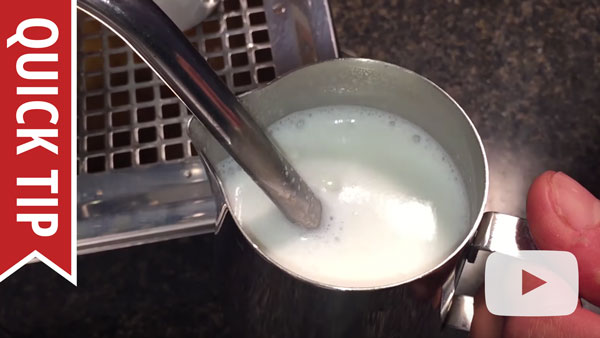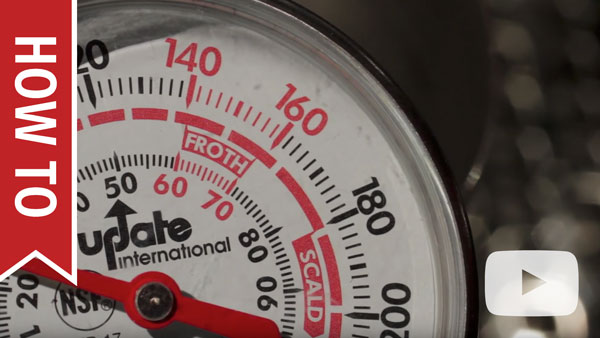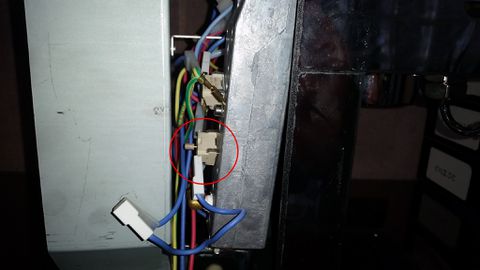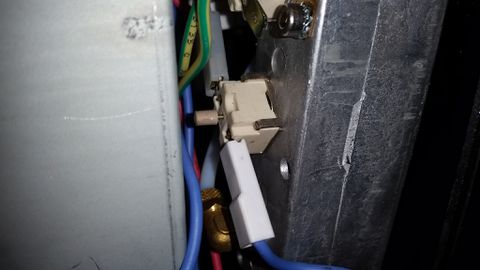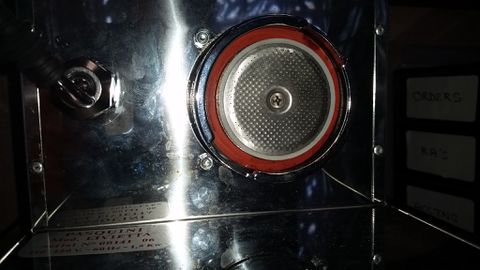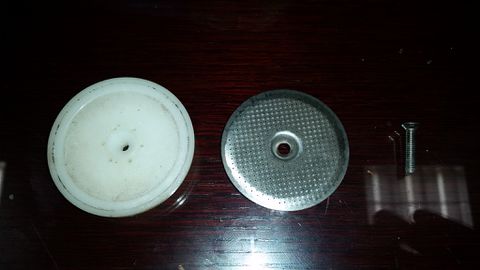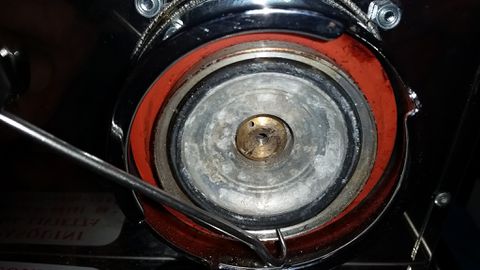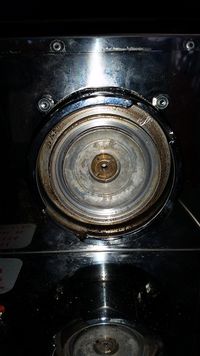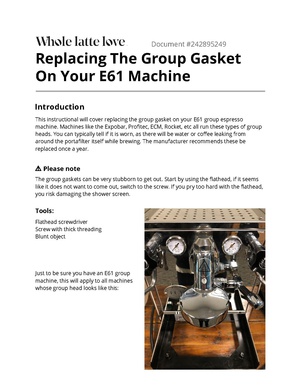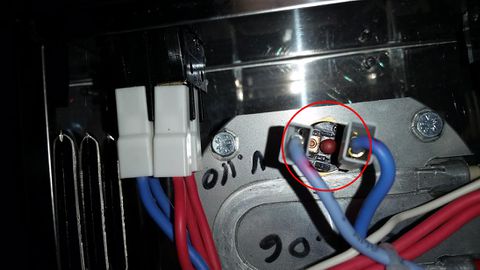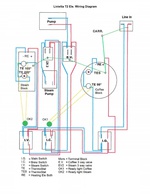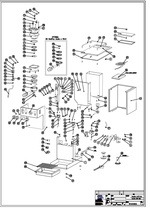Pasquini Livietta T2
From Whole Latte Love Support Library
The Pasquini Livietta T2 is a compact Semi-Automatic espresso machine featuring thermoblock boilers.
| Pasquini Livietta T2 |
|---|
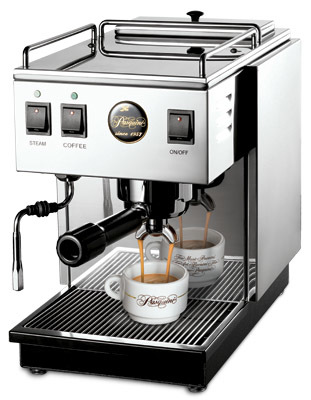
|
| Manufacturer: Pasquini |
| Model Name: Livietta T2 |
| Type: Semi-Automatic |
Contents
[hide]Getting Started
Basic Usage
The video below shows the basic usage of the original Livietta unit, but the same basic procedures apply to the updated T2 version.
Removing The Cover
Some minor maintenance may require the cover of the machine be removed.
- The top will need to be removed first. The cup warmer is secured by two hex screws on the top, which can be removed with a 3 mm. allen key.
- Once the screws are removed the top will simply lift off and can be set aside.
- There will be another two hex screws securing the side paneling. These screws can be removed with a 2.5 mm. allen key.
- Once the screws are removed the side paneling can be gently lifted off. There are metal tabs on the bottom of the side paneling which slip behind the frame of the machine.
- When reassembling the machine make sure the metal tabs on the side paneling are pushed in, so that they are slipping behind the frame, towards the inside of the machine.
Cleaning & Maintenance
Proper machine maintenance is critical for machine function. Most machine failures are caused by lack of cleaning and many manufacturer warranties do not cover cleaning related breakdowns, so it is important to keep a regular maintenance schedule. Listed below is a suggested maintenance schedule for most semi-automatic espresso machines:
Descaling
This machine MUST NOT be descaled. The boiler style this machine utilizes is not compatible with the descaling process. Any cleaning agent that is run through this machine would get stuck in the system and render the machine unusable. Instead, backflushing is the primary cleaning process for this machine.
Backflushing
The machine should be backflushed once a week to prevent scale buildup in the grouphead and valve assemblies.
Grouphead Cleaning
The grouphead should be taken apart on a monthly basis to remove scale buildup, remove coffee residues, and improve shot flavor.
Steam Wand Cleaning
Steam wands, steam tips, and nozzle attachments should be cleaned daily after the machine is finished being used for the day. Milk residues quickly build up on steam wands and frothing nozzles, so it is important to keep these clean to prevent blockages from forming.
Replacing Group Gasket
The group gasket will typically need to be replaced about every six months to a year. It is not necessary to replace the gasket until leaking at the grouphead occurs, but it is good to have a gasket on hand since the machine cannot be used with a broken gasket.
Recommended Cleaning Products
The best product for backflushing or cleaning metal grouphead components and filter baskets is Urnex Cafiza.
Troubleshooting
No Crema or Bad Tasting Shots
Typically, issues with crema or the flavor of the shot do not indicate a malfunction of the machine. Instead, this indicates that an adjustment needs to be made in the brewing process or that different beans need to be used.
The following articles review the different variables and offer solutions:
- Tamping The Correct Way and The Effects Of Tamping Pressure
- Grinding Coffee For Espresso
- It is important to use fresh beans, typically beans roasted within the past two weeks are best. Light and medium roasts are best for espresso brewing and richer crema. Storing beans properly is also important, more information can be found here.
If the behavior persists after reviewing these factors then the machine may need to be cleaned. Lack of cleaning can cause burned or bitter flavors, or create flow issues which can result in a weak shot. Navigate to the Cleaning & Maintenance icon above for more information.
Difficulty Frothing
As with brewing, technique is critical to frothing well. Frothing is very sensitive to technique, which has a steep learning curve. If the machine is producing steam then an adjustment to technique may need to be made. The video on the right shows proper frothing technique.
Many frothing mistakes are common missteps that result in poor or no froth. The video on the right identifies these mistakes and shows how to correct them.
It is also important not to overheat your milk. The milk will have the sweetest and most velvety texture between 140-150 F°. As you froth past this point the milk will lose its sweetness, the froth will take on a gummier texture, and eventually the milk will scald and begin to taste burnt. The video on the right explains how to use a frothing thermometer so that the milk is kept within the ideal range.
Flow Issues
The first place to start with any flow issue is cleaning the machine. Before going through these steps please make sure the machine is cleaned according to the Cleaning & Maintenance section of this article.
No Steam From Wand
- Check the brew function on the machine and see if water is able to flow through the machine for this function. If the brew water is not flowing either refer to the No Flow At All section of this article
- If cold water is squirting out of the steam wand at regular intervals instead of steam, then the high limit switch on the thermoblock has tripped and needs to be reset.
- Unplug the machine and let it cool off. Thermoblocks will retain heat for a while, so they will need time to cool down before the machine can be safely opened.
- Remove the top and cover of the machine in order to access the internal components. Once the cover is removed turn the machine so that you are facing the left hand side of it, where the steam thermoblock is located.
- The high limit reset switch will be located at the back bottom of the steam thermoblock. It may be more easily accessed by removing one of the wires on the steam thermostat, like in the picture above. To reset it press the small white button in the center several times. The button won't click, but pressing on it will reset it.
- Reassemble the machine and test the steam function again. If the machine still will not heat then the machine should be repaired professionally.
- Remove the tip from the steam wand and test the flow. If flow is restored then the tip needs to be cleaned and reattached.
- If the flow is still blocked then there may be a blockage in the steam wand itself. Clean the wand by using a pipe brush that has synthetic or plastic bristles; metal bristles can damage the wand. Then soak the wand in a solution of hot water and backflushing powder for ten minutes. Test flow again.
- If there still isn't flow then there may be a blockage farther back in the steam circuit. The machine may need to be professionally cleaned to remove the blockage.
Only Flow From Steam Wand
Try these steps in the following order. Between each step test the machine for flow. If flow is restored to the machine do an immediate descale of the unit before returning to normal use.
- Test the flow of the machine without the portafilter attached. If the machine flows with the portafilter removed then one of the filter baskets is blocking the flow. Clean the baskets by soaking them in a solution of hot water and backflushing powder for 30 minutes, or boiling the baskets for 30 minutes.
- Make sure the grouphead is completely clean and free of debris. Be sure to completely disassemble the grouphead for cleaning.
- To clean the group head first unplug the machine and remove the water reservoir and drip tray.
- Place down a soft cloth or towel and gently tilt the machine on its back.
- Use a philips head screwdriver to remove the screw on the bottom of the grouphead. The grouphead is more easily accessed through the cutout in the frame beneath the drip tray.
- Once the screw is removed the shower screen and the diffuser plate can be removed. The three parts shown below should be what comes off of the machine.
- Soak the screw and the shower screen in a solution of hot water and backflushing powder. Clean the shower disc with water and a plastic scrubby sponge; do not soak it in the solution with the other parts, as backflushing powder contains chemicals that can degrade plastic.
- Take a grouphead cleaning brush, or an old toothbrush, and use it to scrub down the grouphead, especially the group gasket. Remove any buildup of coffee residues or grounds; the gasket in particular needs to be clean in order to seal properly with the portafilter. A pipe brush or toothpick can be used to remove scale buildup from the hole in the center of the grouphead.
- After the components are clean the grouphead can be reassembled and then flushed with water by running the brew function.
No Flow At All
If the machine is not outputting any water follow the instructions below. Once flow is restored make sure to pull a full 8 oz. of water using the hot water function to ensure the machine is correctly primed.
- Check the water tank to make sure it is filled to the max line.
- Make sure the tank is sitting flush, and that the water tank valve is properly inserting in the socket.
- The water tank magnet may be sitting in the machine incorrectly, or the water tank sensor wiring may be loose or disconnected. The machine will not function unless is senses that water is in the tank.
- Test the valve at the bottom of the water tank to see if water flows through properly. Hold the tank over a sink and press on the yellow rubber button on the bottom of the tank. Water should flow out when this is pressed.
- Activate the brew function on the machine. You should hear a vibration noise coming from the machine to indicate that the pump is activated.
- If you can't hear anything coming from the machine then there may be a loose or disconnected wire inside of the machine. Unplug the machine and remove the casing to inspect the inside for any loose or disconnected wires, particularly at the pump or the front switch panel. Firmly secure any loose wires and test flow again using the hot water function.
- If you hear the machine vibrating then the pump is turning on. Unplug the machine and remove the casing to inspect the water lines inside the machine. Make sure there aren't any loose, kinked, or disconnected hoses anywhere.
Machine Is Leaking
Between Portafilter & Grouphead
If the machine is leaking from between the grouphead and the portafilter then the grouphead gasket is either pushed out of place and needs to be reinserted properly, or the gasket is worn out. Typically, grouphead gaskets will wear out in approximately 6 months to a year depending on how heavily the machine is used. Premature wear to this gasket can be caused by using excessive force when attaching the portafilter. It is important to distinguish where the leaking is occurring. If the leaking is originating from farther up on the grouphead assembly and then draining down to where the portafilter is attached, then refer to the section of this article which discusses leaking from the grouphead.
If the leaking is coming from between the portafilter and grouphead where you twist the handle on, then the gasket will need to be replaced.
- To clean the group head first unplug the machine and remove the water reservoir and drip tray.
- Place down a soft cloth or towel and gently tilt the machine on its back.
- Use a philips head screwdriver to remove the screw on the bottom of the grouphead. The grouphead is more easily accessed through the cutout in the frame beneath the drip tray.
- Once the screw is removed the shower screen and the diffuser plate can be removed. The three parts shown below should be what comes off of the machine.
- Next there are two gaskets in the grouphead that need to be removed. Use an awl, or a small flathead screwdriver to pry these parts out. Take care not to scratch/gouge the metal of the grouphead. An awl with a curbed tip will be easiest for slipping underneath the gaskets and pulling them out.
- Take a grouphead cleaning brush, or an old toothbrush, and use it to scrub down the grouphead, especially the group gasket. Remove any buildup of coffee residues or grounds. A pipe brush or toothpick can be used to remove scale buildup from the hole in the center of the grouphead.
- Firmly press the new group gasket and shower disc gasket into place. Make sure the orange grouphead gasket is sitting flat and not twisted at all. If the gasket is not seated properly the portafilter will not seal with the grouphead and leaking will continue.
- Soak the screw and the shower screen in a solution of hot water and backflushing powder. Clean the shower disc with water and a plastic scrubby sponge; do not soak it in the solution with the other parts, as backflushing powder contains chemicals that can degrade plastic.
- After the components are clean the grouphead can be reassembled and then flushed with water by running the brew function. You can try using the instructions to clean and reseat the current gasket. If that does not resolve the leak then the gasket will need to be replaced.
The gasket can get stuck in the grouphead from wear or excessive heat exposure. To remove the gasket take some self-tapping screws and partially screw them into the group gasket. Make sure not to go all the way through the gasket because you can scratch/dent the grouphead if you go too far. Then use a pair of pliers to pull on the screws and the gasket will pull out with them.
From Bottom Of Machine
- Check the water tank and drip tray to make sure that are no cracks or breaks where water can escape. Make sure they are properly positioned on the machine; the valve on the bottom of the water tank needs to be fully inserted into the corresponding socket for it to seal properly. If the tank is pushed in most of the way, but not all of the way, the valve at the bottom of the tank will open and release water. Also make sure the drip tray is pushed fully back. The machine has two solenoid valves which relieve water into this tray from just behind the face plate of the machine.
- Unplug the machine and remove the cover and top. Check for any loose or broken water connections, or any valve assemblies that are leaking.
- Examine the two pumps and the thermoblock assemblies to see if there are any cracks in them. If the machine was exposed to subfreezing conditions without being properly drained it can cause these parts to crack.
From Steam Wand
This machine utilizes a thermoblock system, so the machine produces steam on demand, and water is not stored in a boiler. There is a separate pump which activates to push water through the steam thermoblock. When this pump is not active water will not pass through the system. Any dripping or leaking from the wand when the steam function is turned off is most likely condensation, and is perfectly normal.
Machine Not Heating Or Powering On
No Power
- Make sure the machine is plugged into an appropriate power source.
- Do not use the machine on a surge protector. This machine has a high power draw, more than a typical kitchen appliance such as a refrigerator or a microwave. Surge protectors are typically not rated to handle the amperage this machine requires.
- Try using the machine on a different outlet, and make sure the machine is the only appliance plugged into that outlet.
- Make sure the power switches are functioning properly and not broken. If the machine isn't powering on try pressing and holding the power button in the on position to see if the machine turns on. If you are able to power the machine on this way then the power switch needs to be replaced.
- If the machine recently had a leak, had water spilled on it, or any other exposure to moisture then the machine may be shorting out. Try letting the machine sit unplugged for 48 hours to make sure there isn't a short caused by moisture.
Brew Not Heating
- Give the machine sufficient time to heat up. It can take up to ten minutes for this machine to be sufficiently heated for optimal brewing. Make sure the portafilter is attached during heating.
- Make sure the brew indicator light has come on to indicate the machine is heated.
- While the water in the boiler may have heated to the correct temperature within minutes the grouphead may still be cold. If the grouphead is still cold then the temperature of the brew water will be drastically reduced once the water exits the boiler and comes into contact with other cooler components. This is why it is important to give the machine at least ten minutes to fully heat.
- It is important to use preheated cups for the best results.
- If the brew water is completely cold then the high limit switch has probably tripped. The high limit switch prevents the boiler from overheating.
- First remove the casing; only the top panel needs to come off, the side paneling can be left on. Make sure the machine is cooled off and unplugged so that it can be worked on safely.
- Once the top cover is removed the brew high limit switch can be accessed. It is located on top of the boiler, which is at the very front of the inside of the machine. Check to make sure all of the wires leading to the brew boiler are properly attached and in good condition.
- To reset the high limit switch press the red button in the center several times.
On But Not Heating
If the machine powers on, but neither of the functions are heating, then both high limit switches have tripped, or there may be a loose wire somewhere inside the machine.
- Unplug the machine and make sure it is cooled down so that the inside of the unit can be worked on safely.
- Remove the casing in order to access the inside of the machine. Inspect the machine for any loose, disconnected, damaged wires.
- Reset both high limit switches.
- Once the top cover is removed the brew high limit switch can be accessed. It is located on top of the boiler, which is at the very front of the inside of the machine. Check to make sure all of the wires leading to the brew boiler are properly attached and in good condition.
- To reset the high limit switch press the red button in the center several times.
- Turn the machine so that you are facing the left hand side of it; this is where the steam thermoblock is located.
- The high limit reset switch will be located at the back bottom of the steam thermoblock. It may be more easily accessed by removing one of the wires on the steam thermostat, like in the picture above. To reset it press the small white button in the center several times. The button won't click, but pressing on it will reset it.
- Reassemble the machine and test to see if the functions will heat.
Portafilter Handle Not Fitting On Machine
- On all new machines, the portafilter may or may not fit perpendicular to the machine. This is perfectly normal. This is because the grouphead gasket requires time to wear in before this can happen. As long as you can get the portafilter hand tight onto the machine and brew without leaking, then the machine is operating properly.
- Too much coffee may be dosed into the portafilter. If there is too much coffee in the portafilter, it can press into the shower screen and prevent the portafilter tightening all the way. Reduce the amount of coffee in the portafilter and try again. If you see an indentation from the shower screen in the grounds, then you’ve added too much.
- Check the filter baskets for dings, dents, or any sort of warping. A filter basket that is malformed can prevent the filter basket from sealing up against the group gasket.
- The group gasket has slipped out of place or needs replacing. Please refer to the section of this article which discusses gasket issues for instructions on how to test the gasket or replace it.
Diagrams & Manuals
| Pasquini Livietta T2 | |
|---|---|
| Electrical Diagram: | |
| Hydraulic Diagram: | Not Available |
| Machine Manual: | |
| Parts Diagram: | |
| Service Manual | Not Available |
| Startup Guide: | Not Available |
Specifications
| Basic Specs | |
|---|---|
| Width: | 8.5 in. |
| Height: | 12.5 in. |
| Depth: | 14.3 in. |
| Weight: | 23 lbs |
| Wattage: | 1700 |
| Voltage: | 120 |
| Housing | |
| Housing Materials: | Stainless Steel |
| Drip Tray Material: | Plastic |
| Drip Tray Cover Material: | Stainless Steel |
| Drip Tray Capacity: | 20 oz. |
| Power Cord Length: | 44 in. |
| Cup Height | |
| Max Cup Height: | 3 in. |
| Frothing | |
| Material: | Stainless Steel |
| Steam Wand Style: | Commercial |
| Wand Movement: | Articulating |
| Usable Length: | 3 in. |
| Height Off Counter: | 3 in. |
| Number Of Holes: | 3 |
| Water Source | |
| Reservoir Or Plumbed: | Reservoir |
| Reservoir Capacity: | 57 oz. |
| Reservoir Material: | Plastic |
| Reservoir Removable: | Yes |
| Controls | |
| Type Of Controls: | Rocker |
| Cup Warmer | |
| Size: | 8.5 x 6.5 in. |
| Passive / Active: | Passive |
| Portafilter Data | |
| Material: | Chrome Plated Brass |
| Type: | Commercial |
| Quantity Included: | 1 |
| Weight: | 1 lbs |
| Diameter: | 57 mm. |
| Commercial Filter Baskets Included: | Single & Double
|
| Bottomless Portafilter Available: | Yes |
| Tamper Size: | 57 mm. |
| Brew Group | |
| Material: | Chrome Plated Brass |
| Preheat: | Yes |
| Three-Way Valve: | Yes
|
| Back Flush Capable: | Yes |
| Boiler Data | |
| Number Of Boilers: | 2 |
| Brew Boiler Data | |
| Boiler Type: | Thermoblock |
| Boiler Wattage: | 1400 |
| Boiler Voulme: | Small |
| Boiler Material: | Aluminum |
| Boiler Orientation: | Horizontal |
| Element Location: | Internal |
| Pump Data | |
| Pump Type: | Vibration |
| Wattage: | 52 |
| Max Pressure: | 15 Bar |
| Self Priming: | Yes |
| Performance | |
| Initial Heat Up: | 240 s. |
| Recommended Heat Up: | 420 s. |
| Time To Steam (8 oz.): | 8.5 s.
|
| Hot Water Time (8 oz.): | 30 s.
|
| Sound Level Brewing: | 72 Db |
| details | |
| Country Of Manufacture: | Italy
|
| Recommended Application: | Home |

